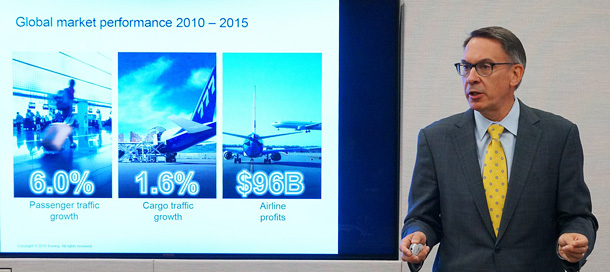Boeing’s Asia growth due to budget airlines

Randy Tinseth, vice president of marketing for Boeing Commercial Airplanes, gives a presentation on the company’s business outlook for the next 20 years at Boeing Korea’s office, located in Jung District, central Seoul on Friday. [BOEING KOREA]
“We have seen a surge in the number of flights being added within the region due to the emergence of LCCs over the past five years,” said Randy Tinseth, Boeing Commercial Airplane’s vice president of marketing, at a press briefing about the company’s 20-year market outlook at its office in Jung District, central Seoul on Friday. “In fact, all domestic growth in Korea has been due to LCCs.”
Boeing’s Northeast Asian business covers Korea, Japan and Taiwan. The weekly frequency of LCC flights in the region increased nearly five-fold from 470 in 2011 to more than 2,700 in 2016, according to data compiled by Boeing through its “Current Market Outlook” report published annually from 1961.
“LCCs from Korea has been at the forefront of this growth,” Tinseth said. Among LCCs in the Northeast Asian region, Korea’s Jeju Air accounts for 12 percent of the business in terms of this year’s weekly flights, according to figures from Flightglobal and OAG.
Korean Air’s low-cost arm Jin Air accounts for 10 percent, followed by Eastar Jet with 6 pecent, T’Way Air’s 5 percent and Air Busan’s 4 percent.
LCCs in Korea have been adding flights to more destinations.
Last month, Jeju Air released plans to expand international flights in the second half of this year. It added flights from Incheon International Airport to Phuket in Thailand, while increasing frequencies of flights from Incheon to Hong Kong and Narita Airport in Japan.
Jin Air, operating Boeing aircrafts, increased its planes from 19 to 22 this year. It introduced three new planes, two B737-800 single-aisle airplanes and one B777-220ER, a medium wide-body plane. The planes were used to expand flights to Japan.
Last month, Air Busan, a subsidiary of Asiana Airlines, added a flight from Daegu International Airport to Fukuoka, after starting a Daegu-Jeju route in June. “We aim to add three more international flights from Daegu, North Gyeongsang,” said Air Busan CEO Han Tae-geun.
Air Seoul, the latest entrant in the local low-cost carrier market, started its first international flight service on Friday while domestic services began in July. Air Seoul is also run by Asiana Airlines.
Boeing predicts airlines in the region will require 1,440 new commercial airplanes valued at over $320 billion through 2035.
Boeing established Boeing Korea in 1988, which grew into a business employing 200 people in eight Korean cities. More than 68 percent of Korea’s total fleet are Boeing jetliners, according to the company.
BY KIM JEE-HEE [kim.jeehee@joongang.co.kr]










with the Korea JoongAng Daily
To write comments, please log in to one of the accounts.
Standards Board Policy (0/250자)